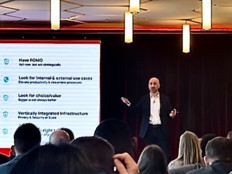Obstacles to Hybrid Cloud Success in Financial Services
This model — experimenting with cloud computing with certain workloads while retaining more sensitive data on more closely held resources — gives the sector a powerful incentive to explore the options provided by hybrid cloud environments, which work with a mix of public and private cloud and on-premises data center resources.
Another challenge that organizations face as they move forward with digital transformation projects is application compatibility. It’s common for financial services organizations to have proprietary applications originally built to run on one environment — say, a mainframe data center they’ve had for many years — that can’t easily be converted to run on a cloud platform. In such cases, the business may have to keep the application where it is while it modernizes code or replaces it altogether.
Unsurprisingly, banks have approached cloud migrations carefully, starting with nonproprietary Software as a Service apps, such as Microsoft 365 and its related collaboration platforms, before moving on to more complex core applications. Many financial services companies expect to retain some applications on-premises indefinitely.
Application compatibility in the age of digital transformation is a major reason that businesses across industries are attracted to hybrid environments, where applications can live on the platforms that best suit them. This does, however, raise questions about how organizations can ensure optimal application performance and security as they run different workloads on different platforms.
LEARN MORE: These digital transformation solutions can grow your business.
Hybrid Cloud Can Create Technical Staffing Challenges
An organization’s internal staff can be a barrier to success. At smaller institutions in particular, it can be difficult to assemble and retain an IT staff with the range of expertise necessary to manage a hybrid environment, because each platform is a little different.
The agile nature of cloud computing also means that staffing needs can fluctuate over time. Cloud platforms make it easier for organizations to experiment with high-end services such as artificial intelligence, but these kinds of services generally require specialized expertise.
This is one area where CDW can help by filling in technical expertise that an organization may lack, on a temporary or ongoing basis. It can often be more cost-effective for smaller organizations to access only the technical expertise they need, without hiring a full-time employee. For businesses that need help in this area, the best place to start is with a consultation.
RELATED: The future of business is in the cloud.
Which Hyperscaler Should Financial Services Organizations Choose?
As they think through their hybrid environments, businesses must also decide which of the major hyperscalers — including Amazon Web Services, Google Cloud Platform and Microsoft Azure — to choose for each of their workloads. Selecting one of the platforms for every cloud-based application may be possible, but it’s more common to work with two or even all three. Some applications simply work better on one than on the others, while others may not work at all. It may also be the case that a particular application has been tested on one of the platforms but not the others.
All of this means that businesses should think carefully about which platform suits each workload best, and about how those applications with interact with others that reside on different platforms. The goal should be to get to an ideal state where applications work seamlessly together, regardless of the platform each resides on. But getting to that point requires attention and some technical expertise.
If you’re thinking that this seems complicated, you’re right. But for financial services organizations that seek to compete in the modern world, technology must enable business outcomes, meaning that an agile, hybrid environment that allows them to update applications and build new ones at will is essential. Yes, such environments are complex, which is why we suggest working with a partner that has experience with all of the major cloud platforms and can deliver impartial advice and technical assistance about migration, security, data backup and recovery, cost, and more.
This article is part of BizTech's EquITy blog series.











